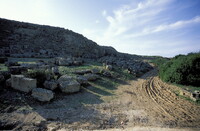Selinunte: Acropolis
unknown (Greek (ancient))

Download1A3-G-SE-1-F1_cp.jpg (585.7Kb)
Alternative Title
Selinus: Acropolis
Date
-650--250Description
East retaining wall (where the acropolis meets the Gorgo di Cottone); Selinus was a Greek colony on the south-west coast of Sicily, some 13 km south of Castelvetrano. It was founded ca. 650 BCE from Megara Hyblaea, on the east coast of Sicily, and flourished as an independent state until it was taken by the Carthaginians in their conquest of 409 BCE; it remained under their rule until abandoned by them in 250 BCE in the face of a Roman attack. It occupied two connected hills between the rivers Hypsas and Selinus; the smaller hill near the sea served as an acropolis with two sanctuaries and was surrounded by fortifications (well preserved); the larger hill inland was the site of the settlement, abandoned after 409 BCE. The site is notable for the remains of numerous Doric temples built of local stone, all now ruined (one partly reconstructed), and was first excavated in 1823 by S. Angell and W. Harris. Later Archaic temples, [such as] D on the acropolis... (?ca. 500 BCE; stylobate 23.63 x 55.68 m), combined the long, narrow cellae, still divided into three rooms, with shorter colonnades (6 by 13 columns). The columns were more widely spaced and the entablatures less heavy, having no ornamental terracottas. Temple D had columns in the pronaos and engaged columns on the antae. Source: Grove Art Online; http://www.groveart.com/ (accessed 2/1/2008)
Type of Work
excavation (site); fortification; templeSubject
architectural exteriors, deities, mythology (Classical), Greek (ancient)
Rights
Rights Statement
Licensed for educational and research use by the MIT community only